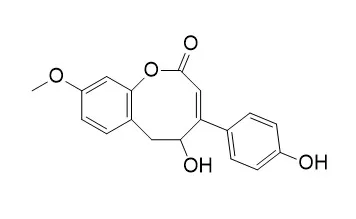| In vitro: |
| Arch Pharm Res. 2010 Oct;33(10):1651-4. | | Phenolic compounds from Pueraria lobata protect PC12 cells against Aβ-induced toxicity.[Pubmed: 21052940 ] |
METHODS AND RESULTS:
Bioassay-guided fractionation of the EtOAc-soluble extract of Pueraria lobata based on the inhibition of Aβ-induced toxicity in PC12 cells resulted in the isolation of four known active compounds, genistein (8), biochanin A (9), sissotrin (10), and Puerol B (11). Of these, genistein (8) and biochanin A (9) exhibited potent neuroprotective effects with ED(50) values of 33.7 and 27.8 μM, respectively. In addition, a new coumestan, 2-(α,α-dimethylallyl)coumestrol (1) was isolated and characterized, but proved to be inactive, as were additional seven known compounds.
The structure of new compound 1 was determined using spectroscopic techniques. | | Arch Pharm Res. 2006 Oct;29(10):821-5. | | Constituents of the roots of Pueraria lobata inhibit formation of advanced glycation end products (AGEs).[Pubmed: 17121174 ] |
METHODS AND RESULTS:
Two isoflavone C-glucosides, puerarin (1) and PG-3 (2), a but-2-enolide, (+/-)-Puerol B (3), two isoflavone O-glucosides, daidzin (4) and genistin (5), and three pterocarpans, (-)-medicarpin (6), (-)-glycinol (7) and (-)-tuberosin (8), were isolated from a MeOH extract of the roots of Pueraria lobata, using an in vitro bioassay based on the inhibition of the formation of advanced glycation end products (AGEs) to monitor chromatographic fractionation. The structures of 1-8 were determined by spectroscopic data interpretation, particularly by 1D- and 2D-NMR studies, and by comparison of these data with values in the literature. All of the isolates (1-8) were evaluated for their inhibitory activity on AGEs formation in vitro.
CONCLUSIONS:
Of these, puerarin (1), PG-3 (2), and (+/-)-Puerol B (3) exhibited more potent inhibitory activity than the positive control aminoguanidine. |
|






 Cell. 2018 Jan 11;172(1-2):249-261.e12. doi: 10.1016/j.cell.2017.12.019.IF=36.216(2019)
Cell. 2018 Jan 11;172(1-2):249-261.e12. doi: 10.1016/j.cell.2017.12.019.IF=36.216(2019) Cell Metab. 2020 Mar 3;31(3):534-548.e5. doi: 10.1016/j.cmet.2020.01.002.IF=22.415(2019)
Cell Metab. 2020 Mar 3;31(3):534-548.e5. doi: 10.1016/j.cmet.2020.01.002.IF=22.415(2019) Mol Cell. 2017 Nov 16;68(4):673-685.e6. doi: 10.1016/j.molcel.2017.10.022.IF=14.548(2019)
Mol Cell. 2017 Nov 16;68(4):673-685.e6. doi: 10.1016/j.molcel.2017.10.022.IF=14.548(2019)